What surprised me most on returning to Boston* for the first time since the onset of the pandemic was just how clustered things are. I’m not a great scheduler and I don’t know the city’s geography particularly well, but after two days spent meeting with more than a dozen startups, it slowly dawned on me that I was mostly operating within a five- to ten-block radius a stone’s throw from MIT (and, for that matter, Harvard).
I’d given myself a little breathing room between meetings and site visits on Friday and was able to walk to all my meetings (the unseasonably warm weather didn’t hurt) — passing several of the spots I’d visited for conversations two days prior. Much like Pittsburgh, Boston has a tight-knit startup community. As companies get bigger, they’ll move to places like Waltham and Bedford on the outskirts, but they’ll remain part of this community nonetheless.
There are several reasons I can see, as an outsider with only passing familiarity:
- It’s less sprawling than a place like the Bay Area/Silicon Valley or New York.
- The startups are often the outgrowth of universities (MIT, Harvard, Northeastern, BU), and there’s a built-in camaraderie there.
- Most people have worked at iRobot at some point.
That last one’s diversifying a bit. Big corporations like Amazon (which may soon absorb iRobot) and Google have moved in as well. But the fact remains that most people aren’t ready to launch a startup right out of college, and these sorts of bigger corporations can be a good place to establish yourself and get a lay of the land. (Though universities are now doing an increasingly good job providing startup resources and accelerating companies after graduation.)
Much like my own industry, everyone sort of knows everyone else, whether personally or by reputation. The longer you stay in a relatively insular industry, the more you’ll find yourself working with the same people time and again, so definitely try not to be an asshole (good advice generally, but doubly so when there can be clear and immediate consequences). You’re going to cross paths with the same people over and over. Life is funny like that.
*I had drinks with a friend on Friday who helpfully noted that not every local is thrilled at the idea of using Boston, Cambridge, Somerville and the like interchangeably. So I’m going to just have to ask forgiveness rather than permission as I attempt to get this newsletter out in a timely fashion. I understand the importance of regional distinctions, as someone who has spent the majority of his life living in both the San Francisco Bay Area and two New York City boroughs, but for the sake of expediency in a very long newsletter, let’s assume all mentions of Boston are a reference to the city’s greater metropolitan area.
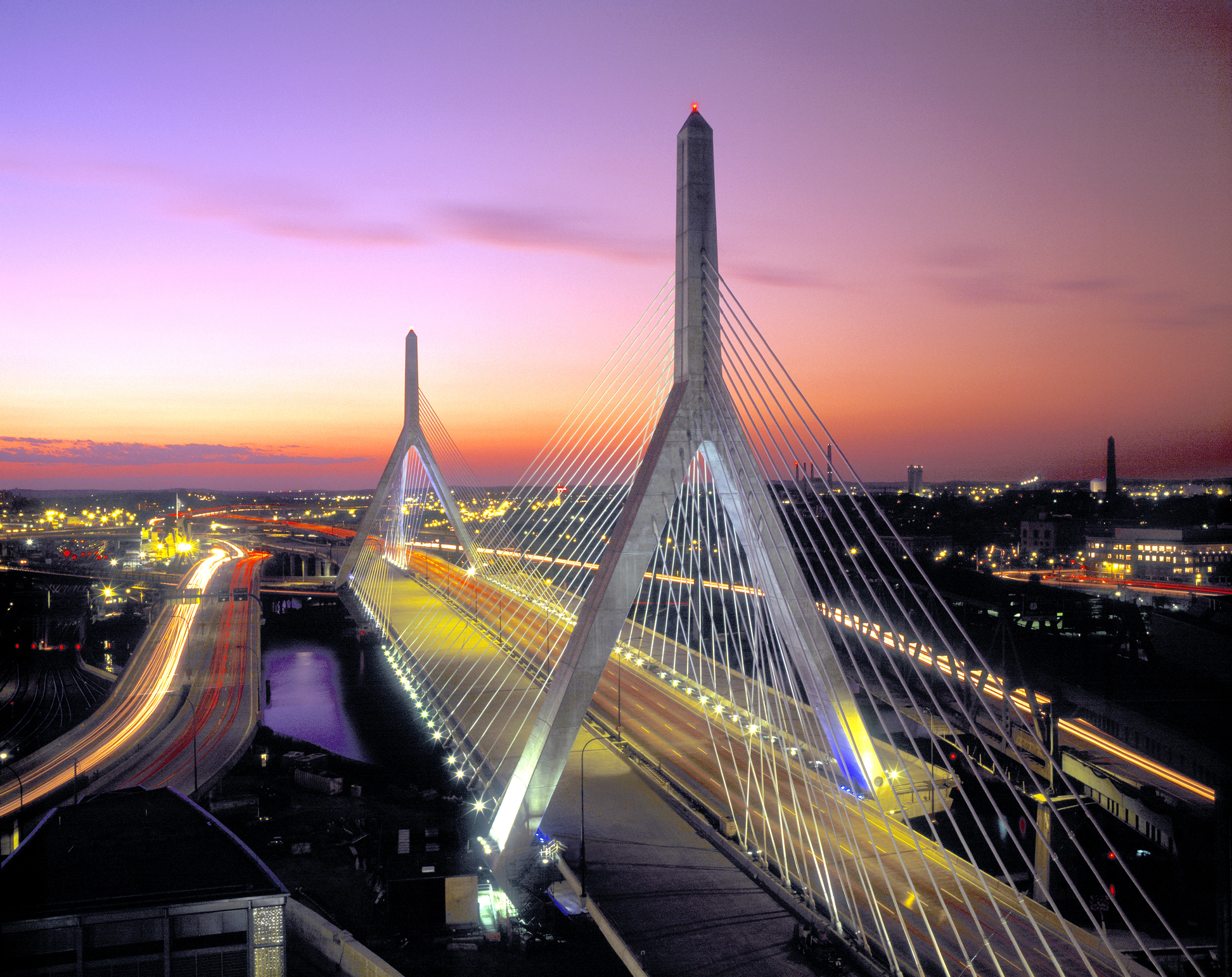
World’s widest cable stayed bridge crossing the Charles River. Completed 2002. Image Credits: Getty Images / John Coletti
This struck me the first time TechCrunch did a small dinner ahead of our first Robotics event. Everyone knew everyone else. And most of them had been through the ranks of iRobot at one point or another. It’s not quite the Willow Garage story, but it’s another very clear case of a hub with a lot of important spokes. It also points to — as numerous people rightfully reminded me over the past week — the fact that we’re still very much in the early days of robotics. It feels like a small community because it is one, in a lot of ways.
That’s exciting. I’ve spent much of my life feeling like I was a bit lately to different parties, but robotics feels new and fresh because it is. Some folks point to the home-brewed computer revolution that pulled in Steve Jobs and Bill Gates as a helpful way to contextualize where we are on the timeline. Others (like Tye Brady below) point significantly further back. I don’t think there’s a direct analog, but I do believe that 15 or 20 years from now, people will fondly remember this as a golden age for robotic discovery.
The energy is palpable when you visit these sites. Much of Silicon Valley has spent the last decade trying to reengineer the same handful of tired apps over and over again (that’s not to say it’s all bad, but there’s a kind of stasis that comes with maturity). Here, however, you can talk to a million people chasing down real-world problems. The speed and excitement at which many of these breakthroughs occur can be head spinning.
Of course, it’s important to remember that they’re standing on the backs of decades of research. Practically every technical founder has some university professor they’ll happily tell you is one of the great unsung heroes of robotics and AI. This, I think, is a big part of the reason why many robotics firms have set up a kind of miniature museum near the building’s entrance. It serves to show how far you’ve come, while providing a tangible connection to where you came from.
Many of the products found on these shelves are a jumble of hastily soldered wires and 3D-printed parts. They’re the results of the excitement that drives people to build things with their hands in an effort to prove out whiteboarded theses. You want to bottle that jolt of electricity you get from the first time a scrappy bit of hardware works as intended and mete it out in those times when businesses become a hard slog and you lose sight of that original vision.

Image Credits: Rise Robotics
I should add here that pivoting doesn’t necessarily qualify as losing sight. It’s extremely common in robotics. You set out to solve a specific problem and find yourself suddenly deeply immersed in another thing entirely. A prime example of that from last week is the team at Rise Robotics, which started life as an exosuit company and is now making massive actuators for heavy machinery. Perhaps the most prominent example in the local community is iRobot, which appears to have spent its formative years in a state of perpetual pivot. Ignore the sunk-cost fallacies as you work to determine how your business might best exist within the confines of late capitalism.
That journey is on display at the company’s headquarters. An industrial catwalk carries the company’s own makeshift museum, which we toured in reverse chronological order, as the actuators shrink from bulldozer to human scale. This is suspended over the startup’s build space, which housed a car mechanic until quite recently. The awning out front still bears the sentiment “Fixing Today’s Automobiles With Tomorrow’s Technology.” It was inherited from the previous tenant, but the sentiment is relevant enough to stick around.
Renovated buildings are a big part of the Boston ecosystem. That’s another bit of shared DNA with the Pittsburgh scene. It’s not specific to startups, either. I spent part of the rainy Friday afternoon working out of Bloc Cafe in Somerville. The coffee shop maintains many quirks of the bank that previously occupied the space, including vaults where you can sit and drink a latte. Multiple people mentioned the nearby offices of Formlabs, housed in a big, brick structure built in the 1870s.
There are competing theories regarding the space’s originally intended use. iRobot occupied the space previously, but a representative from the team tells me that “Formlabs employees still like to find clues around the office.” Prevailing theories include its use as an animal staging area/market and/or slaughterhouse, given some peculiarities about the structure and local history. Oddly, the subject came up twice in two separate conversations on the same day last week. Who knows how many cow corpses haunt the place?

Here I am, watching a video with RightHand, inside their Somerville office. Image Credits: RightHand Robotics
Perhaps the ultimate example of repurposing is RightHand Robotics, which occupies Somerville’s former post office, built in 1935. Listed on the National Register of Historic Places, the building contains a lobby that houses a large mural titled, “A Skirmish Between British and Colonists Near Somerville in Revolutionary Times.” The painting was commissioned as part of the New Deal post office mural project.
Then there’s 750 Main Street in Cambridge. Built in 1910, the massive structure was the longtime home of Polaroid but ultimately lay dormant for several years. Someone mentioned to me that the sewing machine was built there, but those timelines don’t really add up. It’s now home to MIT-supported venture capital firm The Engine, which largely focuses on deep tech, sometimes spilling over into robotics. I was given a tour of the space, which recently underwent a massive renovation. It now has a strong startup feel, with 150,000 square feet of space that includes workshop space, chem labs and offices. The Engine provides space for its own startups and rents offices out to other startups.
The workshop areas contain most of the big, heavy equipment you’d want for product prototyping, from water cutters to circuit board and industrial 3D printers. While it’s true that Somerville is home to world-class maker spaces like Artisans Asylum, this is a more business-focused environment rather than educational, where startups can build and iterate on eventual products. Spaces like these also afford opportunity for early-stage collaboration and, perhaps, cross-pollination between companies.
I heard great things about Greentown Labs but ultimately didn’t have enough time to visit. Also located in Somerville, the space is a climate-focused startup incubator. Rather than taking equity in the companies that come through its doors, Greentown charges a monthly fee for access to offices and labs. The company writes, “Membership fees are approximately market rate, but include so much more than desk and lab space — members also gain access to more than $1 million worth of resources, equipment, programming, staff support, and more.”
While I didn’t get to visit Greentown, I did spend a good chunk of Tuesday afternoon at MassRobotics. Founded in 2015, the organization bills itself as an “innovation hub.” It has, by all accounts, been a welcome addition to the city’s maturing robotics community. It’s also served as an important support mechanism for recent success stories like automation platform Realtime Robotics and service drone firm American Robotics (which recently acquired competitor, Airobotics). The firm expanded its offices with help from a government fund granted back in 2018.
It’s changed a good deal since my last pre-COVID visit, but the nonprofit is still headquartered away from the relative bustling comforts of Cambridge, in the South Boston Waterfront. It’s an industrial space whose entrance is just off to the side of a truck loading bay. There’s a cruise ship docking terminal just across the way, and the closest restaurants have names like Pete’s Dockside and the Dry Dock Cafe. I remember thinking I’d gotten the address wrong the first time I visited.
Certainly a location like this offers plenty of room to grow operations. Big thanks to MassRobotics COO Joyce Sidopoulos, who booked me a conference room for several hours, featuring the wall outlet robot that served as the feature image for last week’s newsletter — a large chunk of which I wrote in that room. When I wasn’t working on that, I was meeting with a handful of MassRobotics startups.
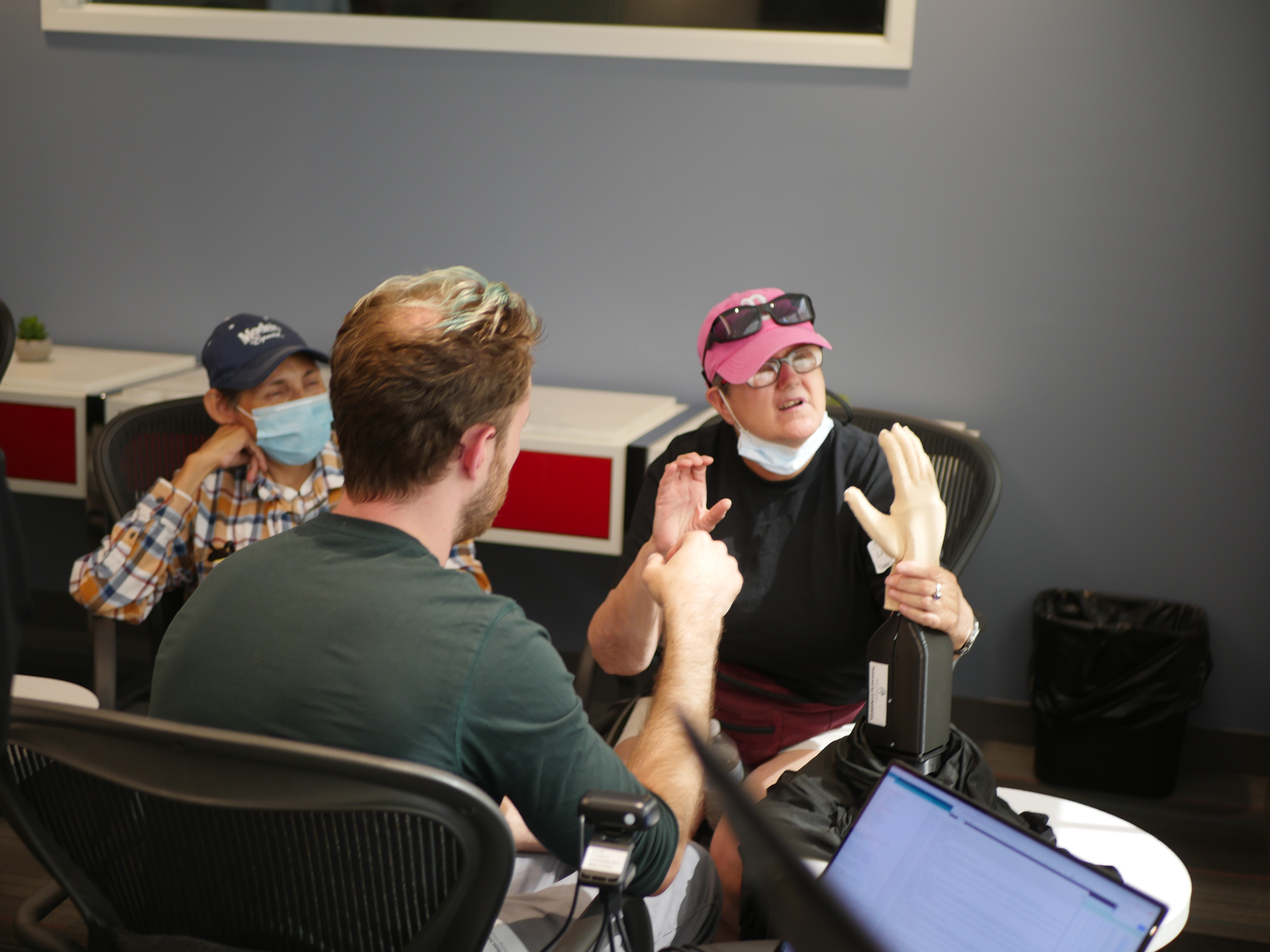
Image Credits: Tatum Robotics
Of note is Tatum Robotics (“Tatum” standing for “Tactile ASL Translational User Mechanism”), which began life as Stephanie Johnson’s undergrad thesis for Northeastern. This job has somewhat cynically caused me to focus on things like total addressable market (hence the “C” in VC), but it’s also important to pay mind to those projects that focused on positive impact, above all.
I’ve seen some wildly divergent figures regarding deafblindness in the U.S., likely due to different severity levels, the distinction between medical and nonmedical diagnoses, and the fact that the condition is often degenerative. That is to say, it often falls under the acquired (the condition occurring later in life) versus congenital (from birth). Whatever the case, this is an underserved community. Tatum cites a study from the World Federation of the DeafBlind that puts the number of severe cases at 0.2% globally and at 0.8% in the U.S.
In our meeting, Tatum showed off its prototype robot hand capable of signing words in real time. The user places their hand on the back of the robot, reading the signs in much the same way they would with another person. The system could be used for audiobooks, the news, and other forms of communication that have traditionally been shut off from the community. Tatum notes:
Over the past two years, we began developing initial prototypes and conducted preliminary validations with DB users. During this time, the COVID pandemic forced social distancing, causing increased isolation and lack of access to important news updates due to intensified shortage of crucial interpreting services. Due to the overwhelming encouragement from DB individuals, advocates, and paraprofessionals, in 2021, Tatum Robotics was founded to develop an assistive technology to aid the DB community.
The company has thus been using pilots to iterate on the technology.
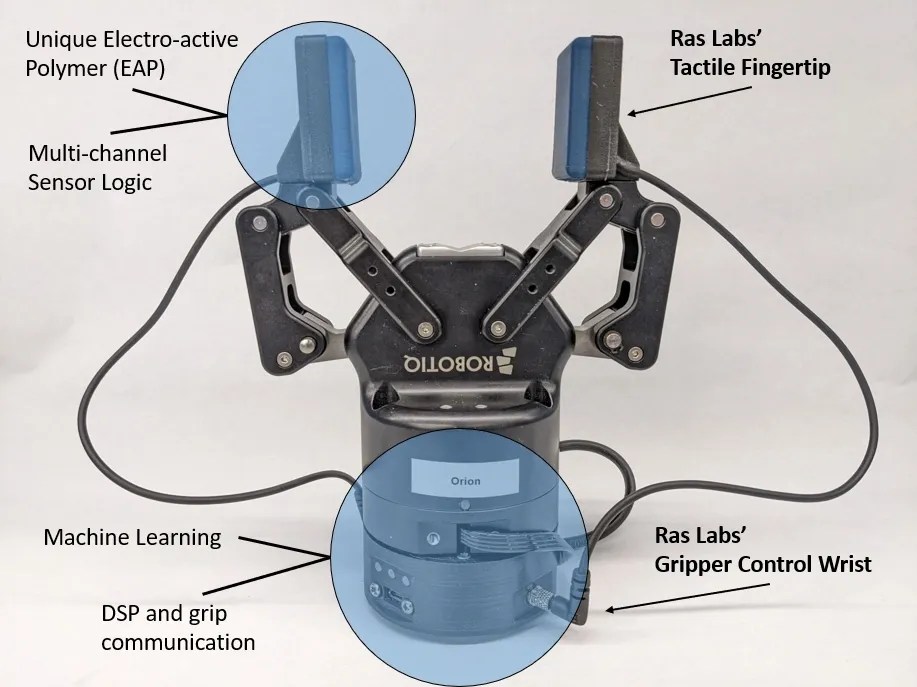
Image Credits: Rar Labs
I also met with the small team at Ras Labs. Or I should say, I met with the small team at Ras Labs again. I didn’t realize until we started speaking that they were the brand-new robotic skin startup we spoke with on my last trip to Boston before the world exploded. The company builds a rubbery “fingertip” electroactive polymer (EAP) pad that brings pressure sensitivity to robotic grippers.
In fact, the thing is so sensitive that the company found itself attempting to determine why it was getting false readings at one point, only to realize that it was picking up the heartbeat felt in the fingers of the employee holding it. The team is currently piloting its technology and hoping to raise funds. They’re also another prime example of a pivot, having begun life with a focus on prosthesis.
The evening culminated with a panel on corporate VC, featuring an interview with Sherwin Prior, who currently serves as the director of Amazon’s $1 billion Industrial Innovation Fund — which, for the record, is sticking around in spite of broader recession-fueled cutbacks at the company. He discussed a kind of “rising tide raises all ships” approach to funding startups outside of Amazon. We’ll go into that a bit more below with the full text of my conversation with Amazon Robotics chief technologist Tye Brady.
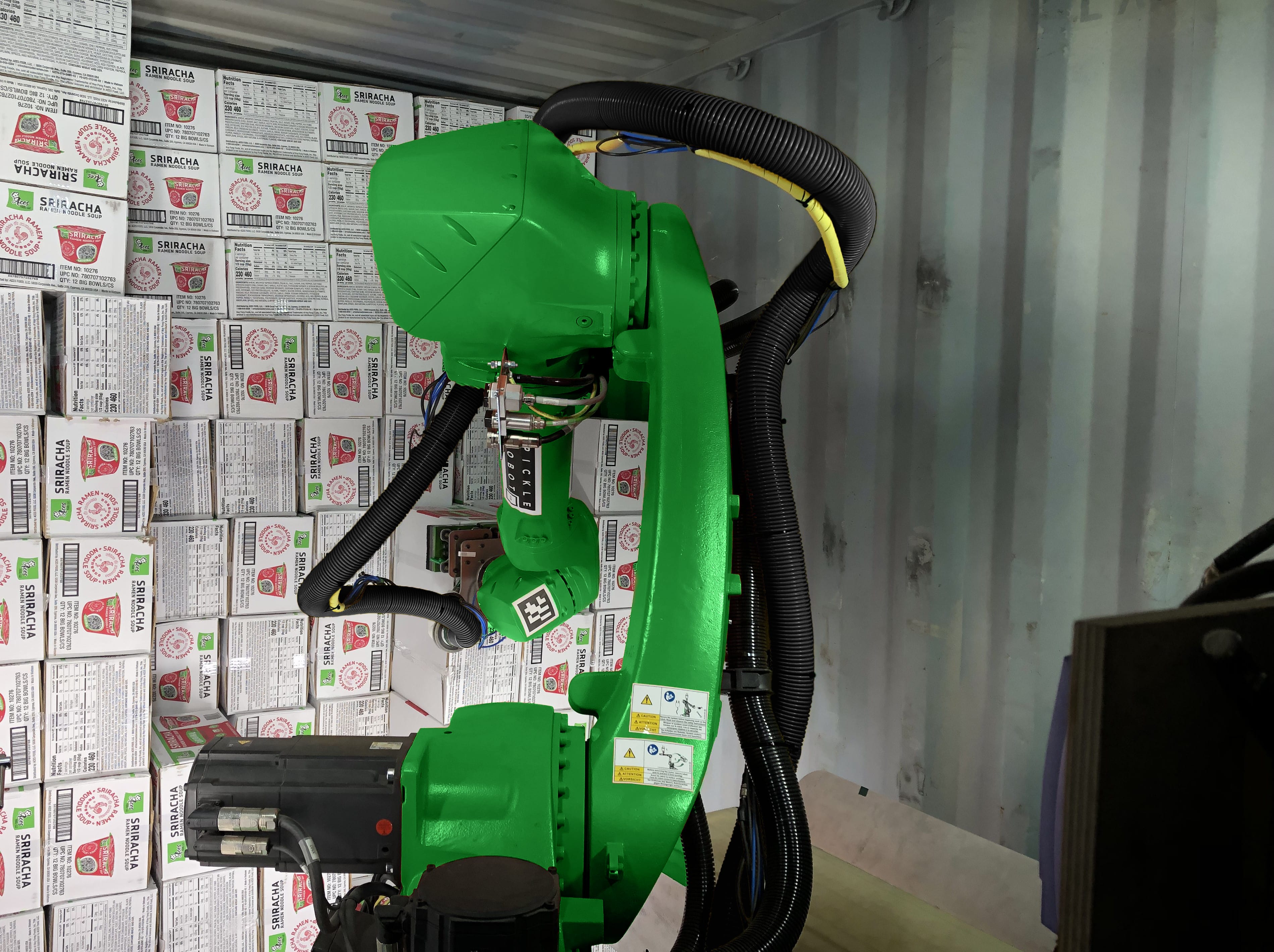
Image Credits: Pickle Robot
Clusters take all sorts of different forms in the Boston Robotics scene. In between intentionally built spaces like accelerators and city blocks with multiple robotics firms sit coworking spaces like Industry Lab. After I noted on social media that I wanted to meet with robotics startups during my few days in Boston, Pickle Labs hit me with a great pitch: meeting four companies in one building.
The timing couldn’t have been better with Pickle. Earlier this week, the company announced a $26 million Series A. Founded in mid-2018 (talk about good timing), its become one of the leading names in truck-unloading robotics. It sounds like a niche of a niche, but it’s a place a lot of companies are looking to automate for the simple reason that these are extremely difficult roles to fill with people.
In addition to the strain of repetitively lifting and moving heavy boxes comes dramatic swings in temperature. Imagine stepping into a shipping container that’s been sitting in the summer sun all day as it’s docked at a warehouse. No wonder some of these companies are posting 100% turnover rates, with new workers leaving after the first lunch break. Companies like Boston Dynamics and Agility have been eyeing the space as well, but Pickle has been developing its own tethered solution for several years now.
“Customer interest in Pickle unload systems has been incredibly strong, and now that we have our initial unload systems out of the lab and into customer operations we have a clear path to broad commercialization,” Pickle CEO AJ Meyer said in a release. “The early customer deployments, financing, and leadership additions set the stage for us to accelerate customer acquisition and build the company infrastructure we need to deliver more systems to more customers in the coming months.”
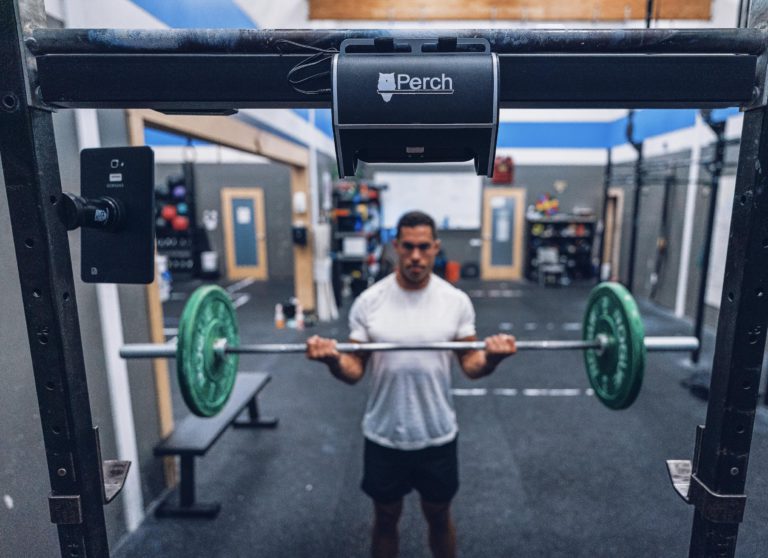
Image Credits: Perch
Also in the building is Perch, an MIT graduate that builds a professional strength training detection system used by several professional sports teams. LeafLabs, meanwhile, was one of the more interesting pivots on display last week. The firm dates back to 2009, when a quartet of MIT students developed a computing board that operated in the same space as Arduino and Raspberry Pi.
Over the years, it’s pivoted to developing hardware for other firms. The company worked on Google’s promising (if ultimately doomed) modular Project Ara phone, as well as Willow, a neurological implant capable of processing as many as 1,024 channels of electrophysiological data. It’s an extremely crafty bunch — the kind of people who just go ahead and build their own faraday cage for in-house testing.
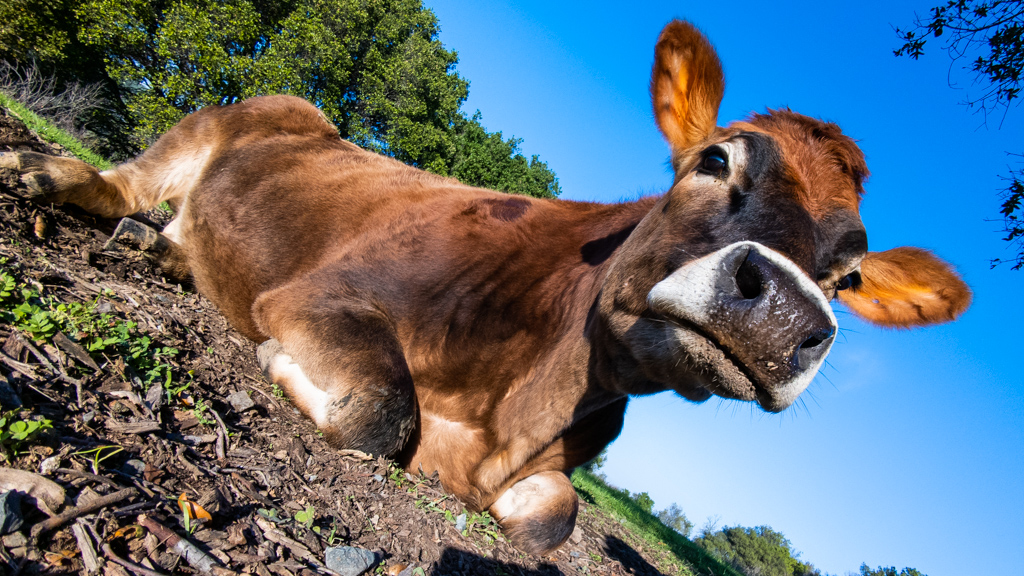
Image Credits: Haje Kamps
Of the group, however, it was Marble Technologies that really jumped out at me. If I’m a robotics VC in 2022, I’m taking a close look at companies operating in some of the world’s least sexy spaces — and it doesn’t get less sexy than a slaughterhouse. As a vegetarian, I have mixed feelings about a company that automates that process, but it does ultimately ease the lives of workers operating in one of the roughest environments imaginable. Perhaps you remember some of the horror stories from early on in the pandemic or maybe you just read “The Jungle” or “Fast Food Nation” at some point.
I should clarify that Marble’s system doesn’t do the actual killing. Instead, the company’s conveyor belt system sits in after the packaging. It uses hardware and AI to automate the sorting process. I was impressed by the automation cells the company produces, though I should clarify that I didn’t actually see one in person. Co-founders Chafik Barbar and Tim Kelsey met at the University of Nebraska, and Marble’s “show room” is located in Lincoln. The firm has generated a good amount of interest in an understaffed industry, with pilots set to begin for its tech.
Categories like fulfillment are big and will continue to grow, but if looking to build and invest in technologies, I’m looking at places like slaughterhouses. There are so many underserved jobs that need to be dragged kicking and screaming into this century. A veteran in the robotics space told me that they had explored the category but ultimately opted not to go any further because, well, who wants to be in the slaughterhouse business, even tangentially?
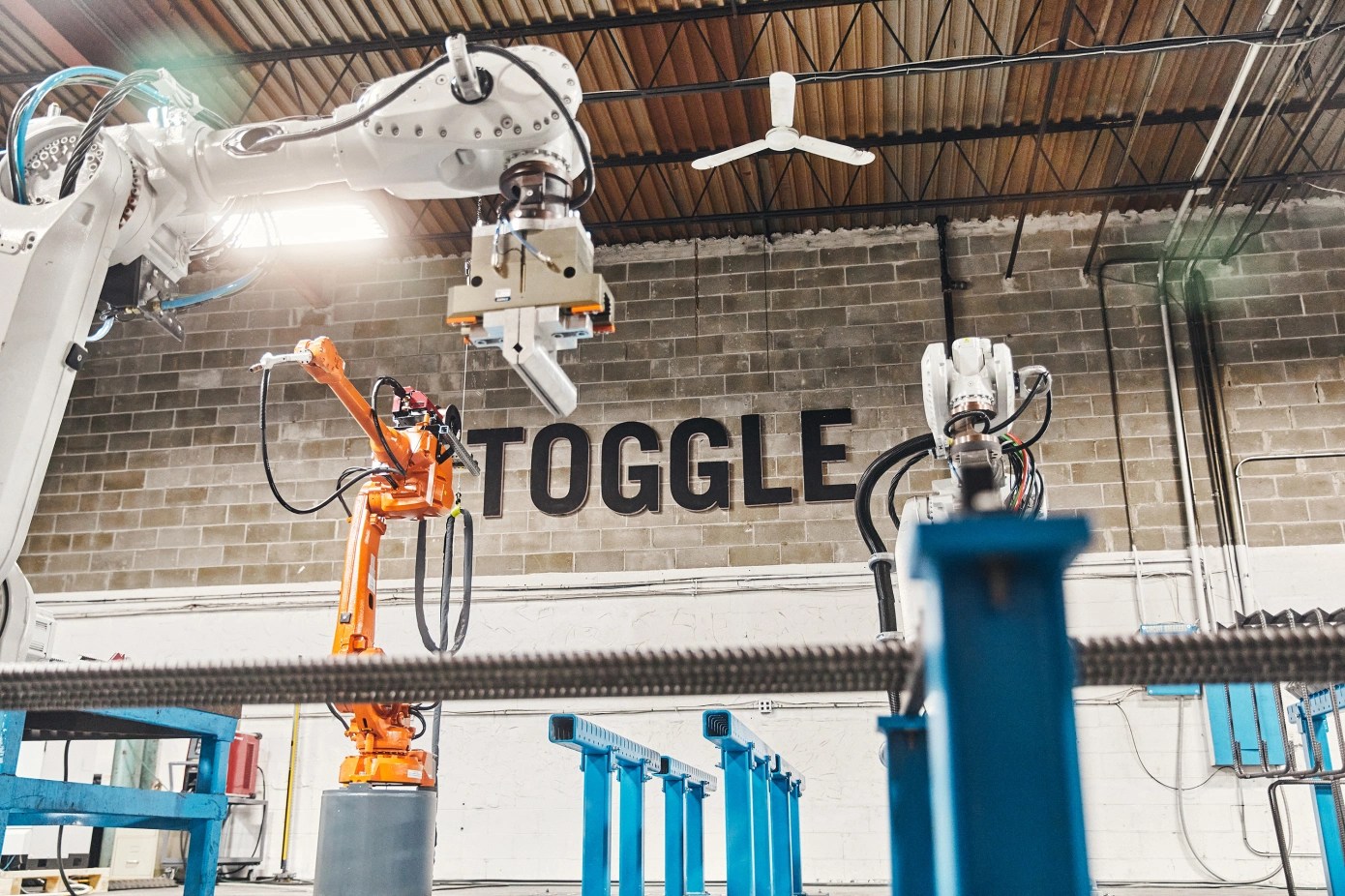
Image Credits: Toggle
Construction and food are still prime categories. I met with someone from Toggle Robotics (somewhat ironically, as they’re actually based in my neck of the woods), who we’d previously covered. An important piece of the puzzle I’d missed earlier is that Toggle isn’t just in the rebar-tying robotics business — it’s also in the just plain old rebar-tying business. That is, in addition to creating and selling the robots, the company has begun selling the rebar itself to clients. It’s a clever way to both prove out the technology for clients while generating revenue in the meantime.
The idea is that once you’ve got enough construction clients buying the product from you, you’ll be able to upsell sell them on buying or renting the robot to save money in the long-term.
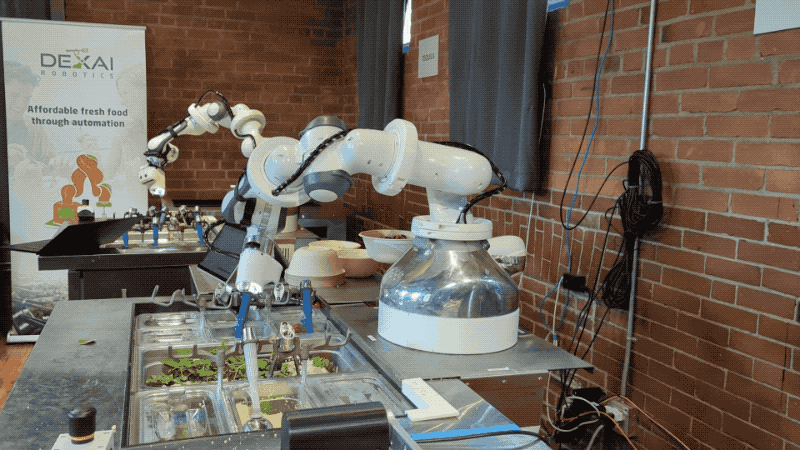
Image Credits: Brian Heater
I also stopped by Dexai’s offices — though sadly a bit on the early side to eat a salad. I admit I was skeptical going into it. Specifically, I wasn’t sure why anyone would invest in a cooking system based around a robot arm, versus the sort of vending machine or even counter-based solutions such as Hyphen’s Makeline.
I won’t say I’m entirely sold on the form factor just yet, but I’m certainly impressed with the implementation. When I arrived at the company’s office, they were putting a quartet of the robots through a kind of stress test. Brian Krieger, the “Chef de Technologie” (and former regular old sous chef), was effectively monitoring four of the systems at once, each making salads with different ingredients. This, the company says, is sort of the ideal scenario: one human to four robots, all working to get through that lunchtime rush.
The secret sauces here are twofold. First is the second arm, which carries the bowl. The second is the system of attachment tools — the robot automatically drops and picks up different utensils. We got to watch as the system learned a new tool in real time, determining how to best hold it (and accidentally dropping some piles of rice as it figured things out). The company currently has a deal to deliver ten of these systems to the military, including one that’s already been installed in a working kitchen.
Adaptability is a big selling point for the arm. The company says that, with the right tool, it can grill steaks, open the fridge, and more. The Alfred system runs $50,000, plus a monthly service fee. The arm itself is a modified off-the-shelf system — which was another theme. To paraphrase someone I spoke with last week, many a startup has gone bankrupt attempting to build its own robot arm. That’s precisely why companies like RightHand are focused solely on the gripper.
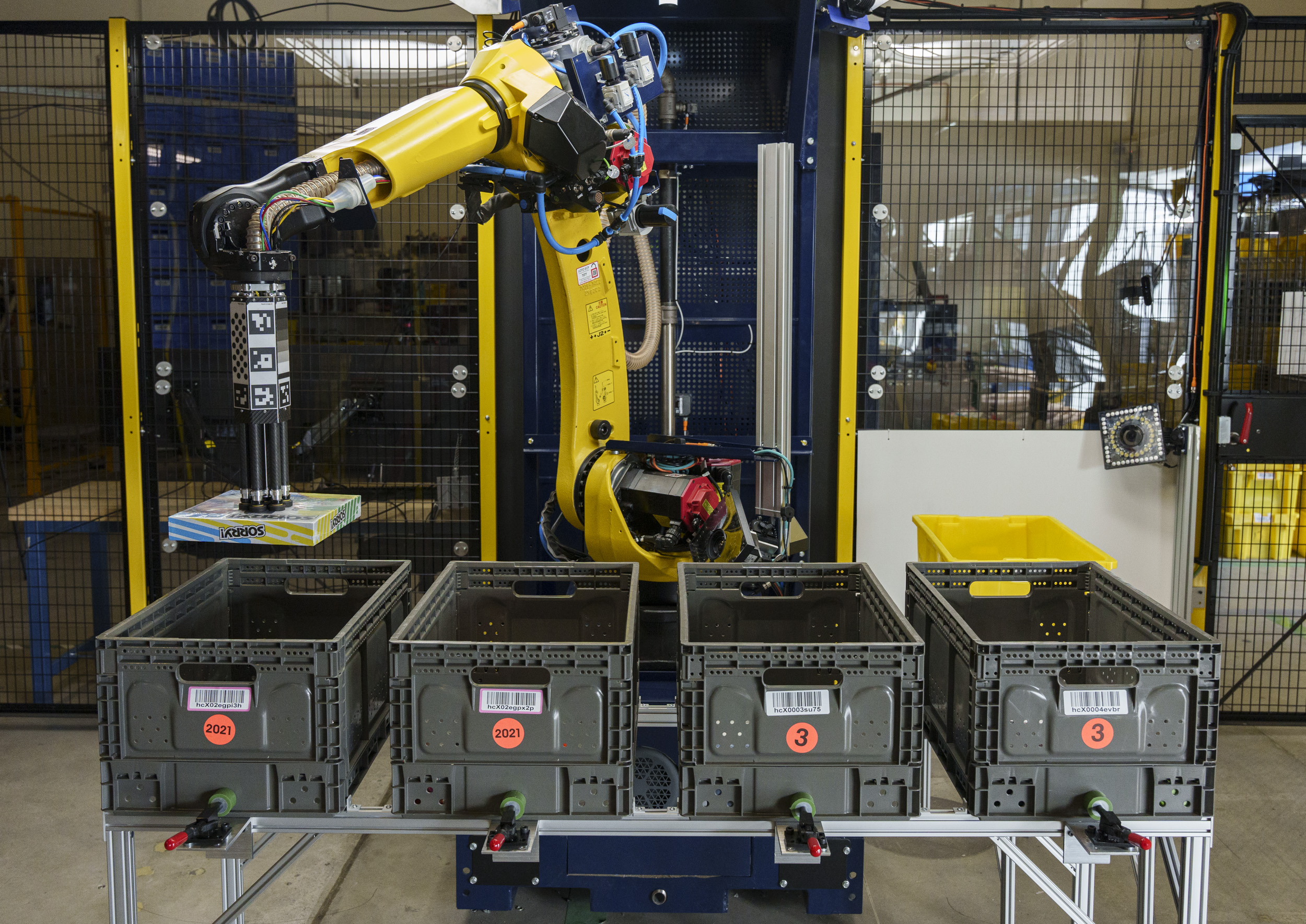
Image Credits: Amazon
Heck, even Amazon didn’t build its own arm. The Sparrow system we saw on Thursday utilizes a modified version of one of Fanuc’s arms — just as the company did with its predecessors Robin and Cardinal.
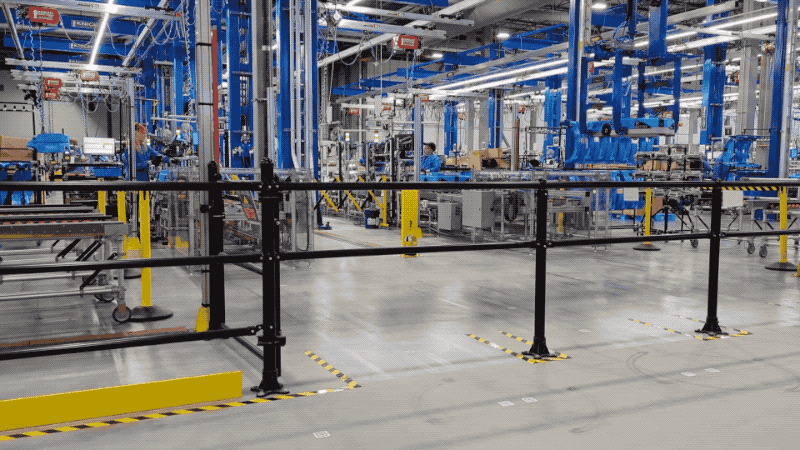
Image Credits: Brian Heater
Of course, in spite of ongoing cutbacks, the company still has more money than God. As such, we’re not dealing with repurposed buildings here. Nor are we talking about life inside a cluster. The company instead opened the massive BOS27 facility about 40 minutes outside of downtown Boston in Westborough, Massachusetts. This is their second major robotics facility in the state after a location on the opposite side of Boston in North Reading. A third space is located in Belgium, following Amazon’s September acquisition of Cloostermans.
What struck me immediately about the space is how much it looks like one of the company’s fulfillment centers. I spent a little time at JFK8 prior to unionizing efforts, and there’s a lot of undeniable shared DNA there. Makes sense that you’d want to do all of your testing in a facility that looks a lot like the one these products will ultimately occupy. In addition to testing, the company also designs and assembles the robots on-site.
I wrote a bunch more about the trip that originally brought me up to Boston. Also, check out a write-up of Amazon’s latest delivery drone design here. With that in mind, I think the best use of our time here is digging deeper into our conversation with Tye Brady.

Tye Brady, Chief Technologist, Amazon Image Credits: Amazon
TC: How has this round of belt tightening impacted your team?
TB: We’re definitely aware of the macroeconomic conditions going on in. You may have seen from Amazon that we’re putting a pause on hiring at this moment. That’s not saying that we’re not making investments. We have the Amazon Innovation Fund for $1 billion. We have what we’re doing with Kuiper, for example, with our satellites and Zooks, Whole Foods. We continue to make those types of investments.
For Scout, we’ve always been — regardless of where we are with the economy — experimental. Sometimes it works out, sometimes it doesn’t, but we always learn from that experience and rolling that into our experiences here in Robotics.
So, Scout was a case of something just not working.
We did a couple of trials and were like, how can we better the customer experiences? It’s the question we always ask in the end, and the signals we were seeing were just, “maybe not at this time.” Not saying that’s forever gone, but maybe not at this time. We like the fact that it’s delivered right to the customer’s door in a timely manner.
I was extremely impressed by Canvas’s technology. We had them onstage right after the acquisition. I assumed that technology had been built into Proteus, but apparently that was a separate project. Was Canvas another case of something not working?
No. We learned a lot from Canvas. We talked to the team, saw the prototypes they wanted to do. We’d been working on prototypes for a number of years, even prior to the acquisition, and got to share some of the technology and real-world learnings from the team. That’s where we are experimenting, and we have that with Proteus.
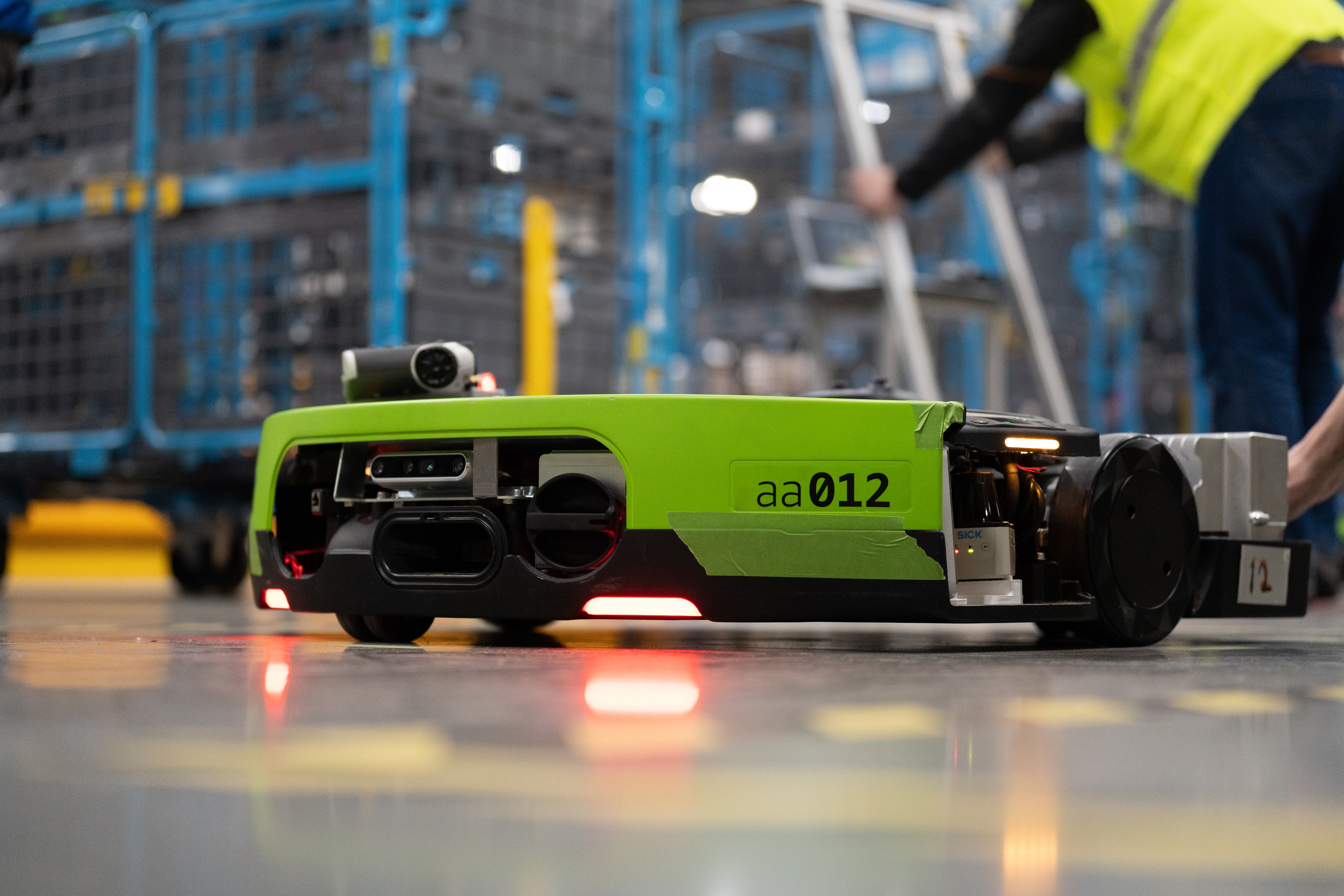
Image Credits: Amazon
Should we anticipate further streamlining when it comes to existing Robotics projects?
We are consolidating inside of Robotics — putting all of Robotics under one roof, which I think is actually really exciting. There’s so many opportunities.
What does “consolidating” mean here? Combining teams?
Yeah, leadership and how we organize ourselves in order to deliver the robotics products that you’ve seen today, or the future products that hopefully we will be announcing coming up. That doesn’t mean that we’re changing investment. There’s still a lot of need for investment in robotics. It has not changed our philosophy at all of people and machines working collaboratively together and that we can give them a better tool set for them to do their jobs, more safely or simply and more efficiently as well.
The robots I saw today are less general purpose and more built with a single purpose in mind. Will that continue to be Amazon’s approach, going forward?
Yeah, although I want to remind you that there are robots like our Xanthus robot. That’s the lower-profile robot that we announced a few years ago. It’s kind of a jack-of-all-trades. It carries much less of a payload, but it can do multiple things, because the need for movement is high. Also, the Proteus vehicle is more general purpose. It does more than containerized carts. We’re approaching the ability to be able to move goods on demand around people.
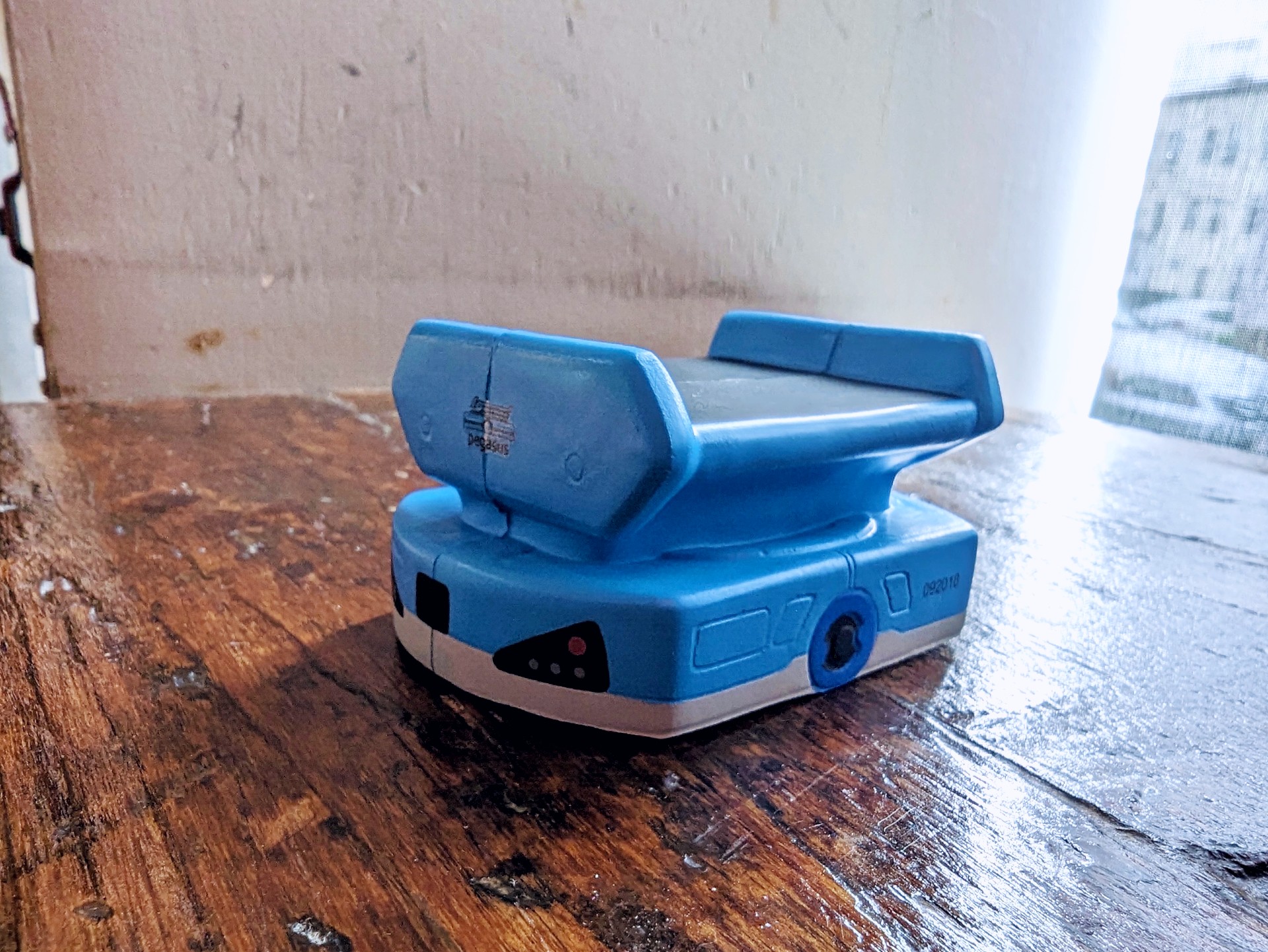
A promotional stress ball version of the real thing. Image Credits: Brian Heater
We don’t do technology for technology’s sake. We use our technology to solve problems. I’m passionate about it because I like to start out teams with what problem we’re trying to solve. And how can we apply our technology in a way that extends human capability? Because they’re very much part of the equation.
There’s been a renewed push for humanoid robots. Musk is obviously one of the big ones there [with Optimus]. Do humanoid robots make sense for what you’re trying to accomplish?
I’m going to give you my answer as a technologist — as a roboticist. This is not the company line. We have to be really careful when we talk about humanoid robots. When you see the human form, there’s an expectation of human capabilities. Human capabilities are incredibly unique, valuable and have been engineered over millions of years. We have common sense; we understand how to solve problems at a higher level. We can look at a situation and just about instantly figure out the best way to do that.
When a robot comes in the human form, I think there’s that expectation that’s initially set. We need to be really careful of that. My philosophy is extending human capability — a helper that will allow me to do more things, that will allow me to be more capable and intelligent . . . in whatever form it takes.
The argument for a humanoid robot is that we build our environments for us, so we should build robots for those environments. That isn’t necessarily the case here, because you’re in a position to rebuild the environment.
That’s a great observation, and that’s one of the ways that we’re accelerating technology development from a roboticist’s point of view in a nonlinear fashion. It’s a semistructured environment where we have people working collaboratively with our machines and we have a process for the flow of goods that I call “technology development with project context.” We have that, but we’re not completely out in the wild, in a city street where there are people all around. […] Eventually, and I do feel this, the work that we’re doing now, in 10, 20 years will actually benefit society as a whole. As we learn the ability to move, manipulate and identify things, I can see that coming into the home.
You mentioned the Fund at the beginning. What’s the end game for Amazon? Is it integrating technologies like Digit into the ecosystem?
We rolled out the Fund this year. It’s a billion dollars that we’re committing to various robotics companies. It’s important to realize that we’re in the very early stages of robotics. If we’re talking computers, we’d be in the 1950s. It’s really that early. The more that we can raise all boats, I think we all win from that.
We realize that not everything needs to be invented inside the walls of Amazon. If we can seed some of these companies and allow them to do technology development with a real project context, then we can ride along with them. As they’re successful, we can learn from them, and if it makes sense, then we can start to incorporate those products into our processes.
Are acquisitions still on the table for Amazon in 2022?
They’re always on the table.
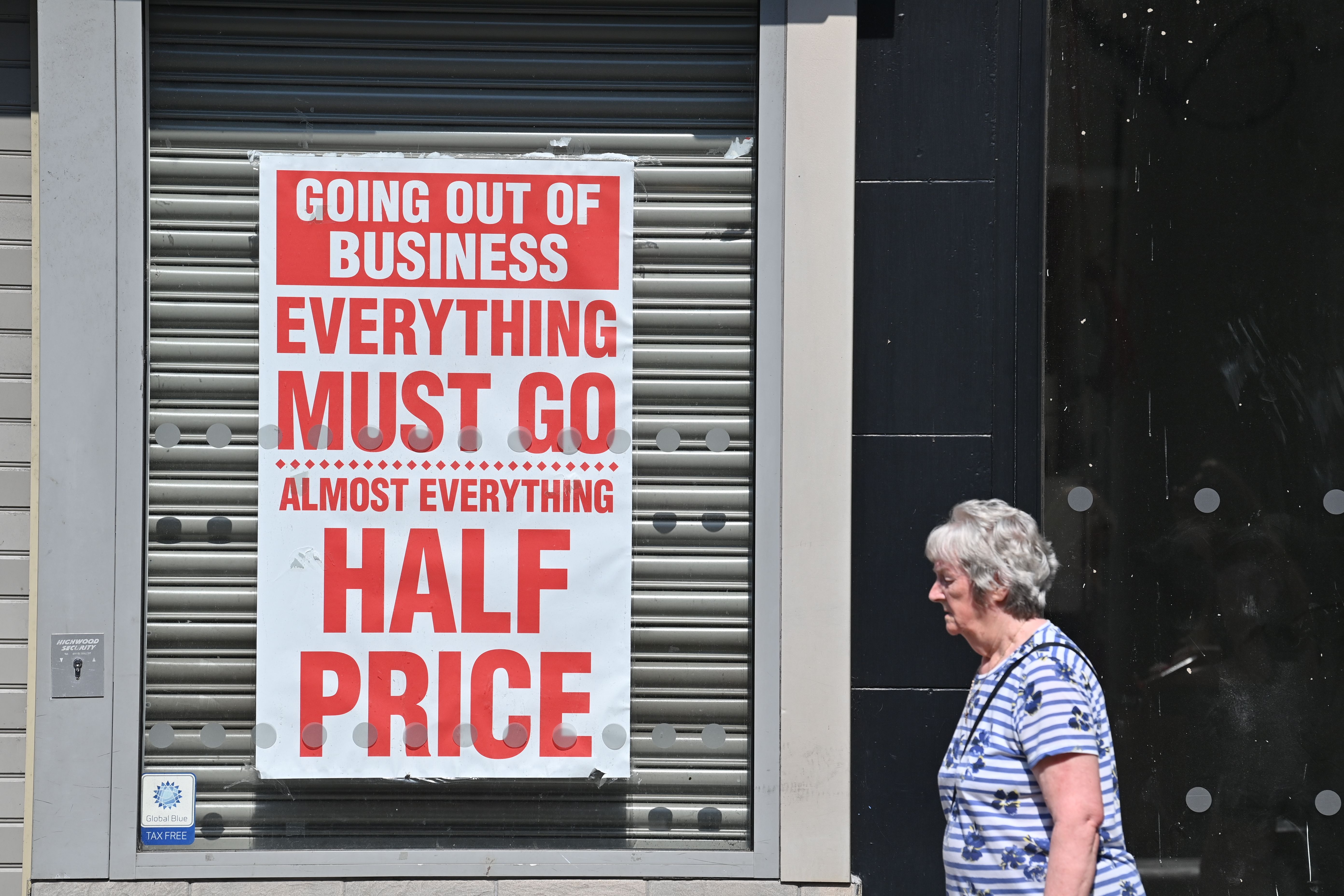
Image Credits: PAUL ELLIS / AFP via Getty Images
Amazon has already left an undeniable mark on the industry — that much isn’t up for debate. Questions do remain, however, what its strategy will look like in the face of both economic headwinds and increased regulatory scrutiny around its proposed acquisition of iRobot (though it’s important to point out that the latter would exist as part of its home robotics division, rather than the industrial Amazon Robotics). Again, the Amazon Fund remains intact, and it seems entirely possible that the company might lean more heavily on outside firms like Agility and BionicHIVE to round out its warehouse robotics ecosystem.
The economy was obviously top of mind the entire Boston trip, to such a point that it took center stage in the above conversation (more reports of big layoffs at the company have arrived in the interim — the latest putting the figure at 10,000). I also made a point to broach the topic with the various founders and VCs I met with during the week.
We’re in a moment of transition for the industry. Robotics and automation were very clearly accelerated by the events of the last few years. First the pandemic, then the resulting ability to fill jobs. This has been a watershed moment for the industry and — until recently — has left investments relatively un-impacted by financial headwinds. This has been the overarching storyline for Actuator for the last couple of years.
But things are changing.
When even Amazon is struggling to figure things out, you know it’s going to be a tough time for startups. I certainly wouldn’t want to be raising money right now, regardless of how strong my project is. For those who are, it’s a simple matter of having no other choice. Waiting for the economy isn’t always an option — I suspect that was at least part of the reason why Iron Ox had to lay off roughly half its staff, for example. Even the longest runways have to end.
One theme I found, however, is that even those companies that are well-positioned have still slowed hiring. This is a period of massive uncertainty, above all. If I’m a robotics startup without tens or hundreds of millions to burn, I’m being exceedingly cautious right now. Hell, even with a big war chest, I’m still playing it close to the vest. Do what you can with what you have and hire strategically. You don’t want to put your employees in the extremely unfortunate position of being laid off because you grew too fast.
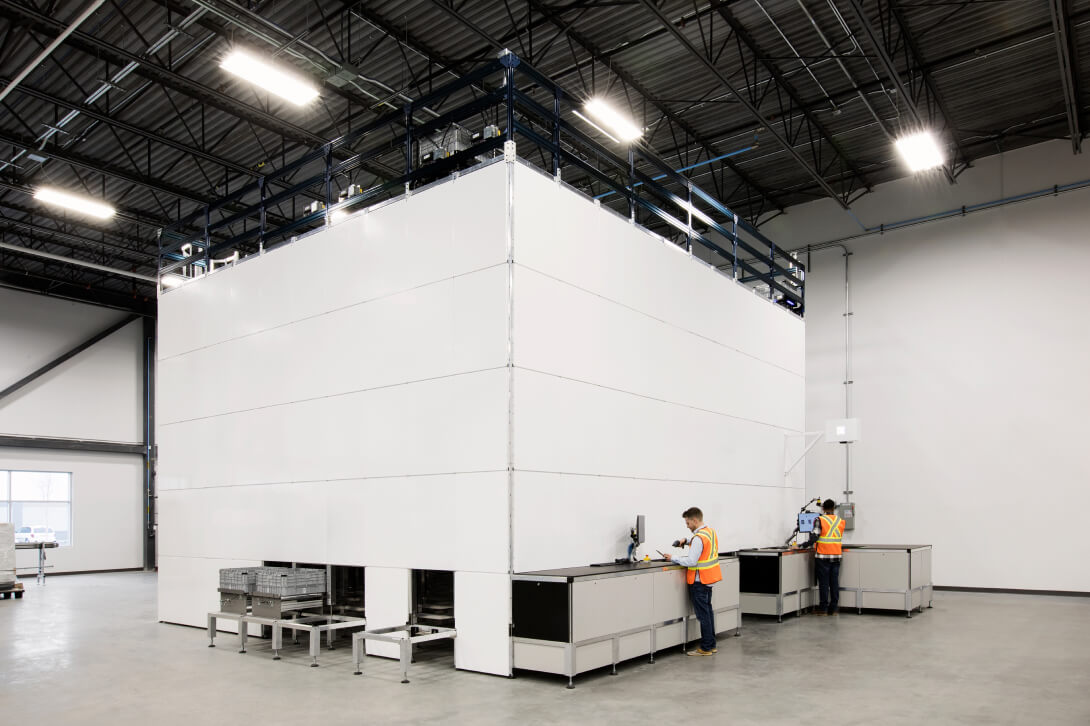
Image Credits: Attabotics
There are, of course, those companies that simply can’t wait for more favorable conditions to start raising. Take Attabotics, which just announced a $71.1 million Series C-1, bringing the Calgary firm’s total raise up to $165.1 million. “We’re not at the stage where we could have [waited],” founder and CEO Scott Gravelle told me on a call this week. “We’ve got some great traction with some great customers. We signed a deal with the DoD. So now it’s time to go from making stuff work to growing the business and deploying it and executing it.”
The company is challenging Amazon’s dominance with a vertical storage solution that uses AI and robotics to locate and retrieve products. The densely packed solution is capable of operating in 15% of the space required by more traditional warehouse solutions. In addition to space savings, that means companies can potentially open more microfulfillment centers in densely packed urban environments, keeping products closer to consumers.
“Amazon remains the best member of our business development team,” Gravelle adds with a hint of snark, “as companies go look for alternatives and look for ways to stay competitive. Amazon has been setting customer expectation in North America for years. They’re the benchmark.”

The Owl Labs Meeting Owl. Image Credits: Owl Labs
Another Boston-based startup, Owl Labs, announced a $25 million raise this week. The company, which produces an AI-powered teleconferencing system, also used the opportunity to announce a new deal with HP.
“The funding will allow Owl Labs to continue its accelerated growth … Owl Labs will use the investment to support product development and increase global adoption of the company’s products, including the [Owl Labs’] product line,” CEO Frank Weishaupt told TechCrunch. “The funding will also be used to expand Owl Labs’ global footprint and deepen go-to-market partnerships starting with a commercial agreement between Owl Labs and HP France, where HP will sell Owl Labs’ products through their local sales team.”
The company has raised $47 million to date.
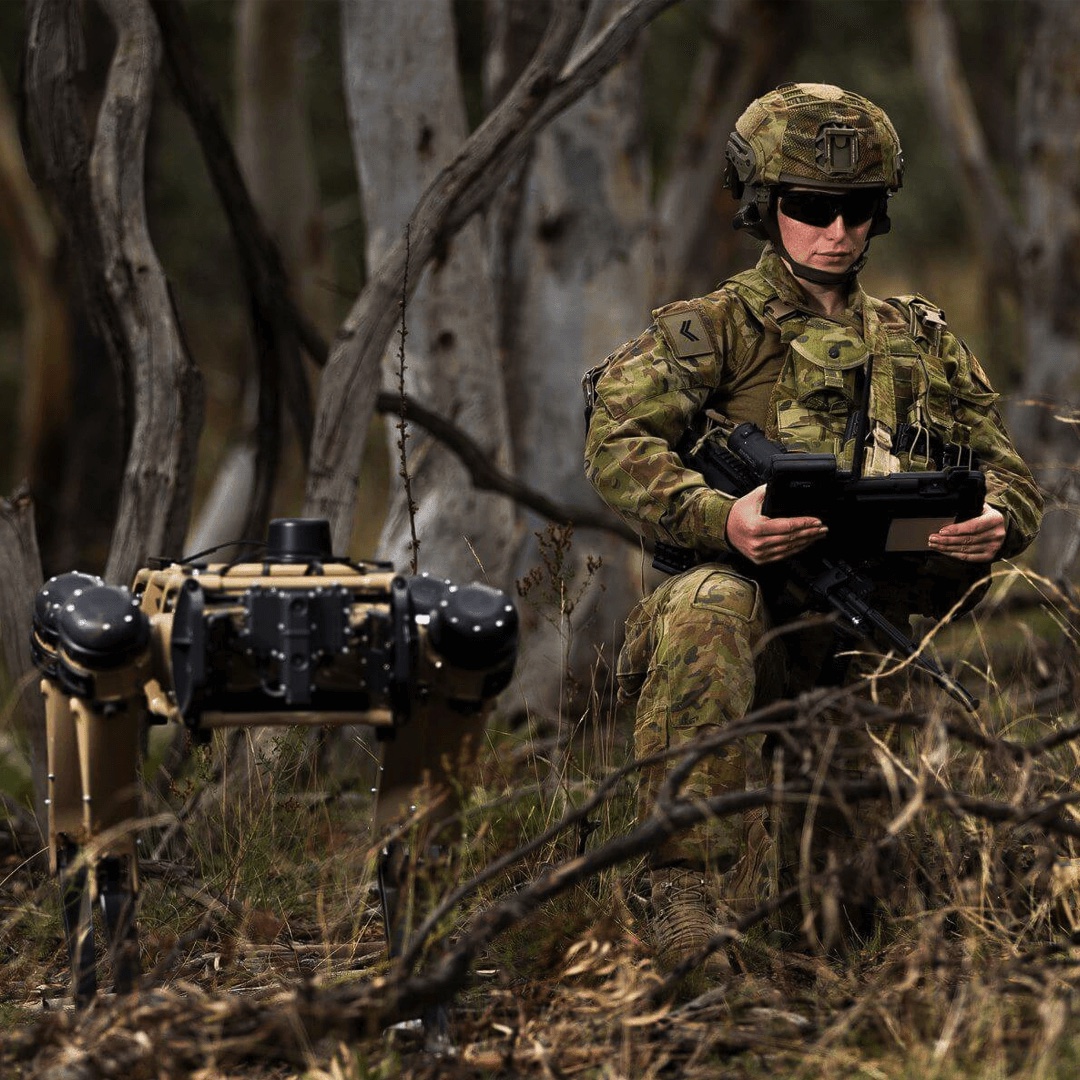
Image Credits: Ghost Robotics
Ghost Robots is back in the news this week, but this time it’s not due to outrage over its bots sporting sniper rifles or being used to patrol the U.S./Mexico border. Nope, this time it’s good old-fashioned accusations of patent infringement. Boston Dynamics recently filed a suit in Delaware accusing the Philadelphia firm of using registered IP in its robotic dog systems. Per the filing, Boston Dynamics said it wrote multiple letters to Ghost Robotics, including a couple of cease and desists.
A spokesperson for Boston Dynamics tells TechCrunch that the company doesn’t comment on pending litigation, but adds:
Innovation is the lifeblood of Boston Dynamics, and our roboticists have successfully filed approximately 500 patents and patent applications worldwide. We welcome competition in the emerging mobile robotics market, but we expect all companies to respect intellectual property rights, and we will take action when those rights are violated.
Boston Dynamics is seeking unspecified damages. Still awaiting comment from Ghost.
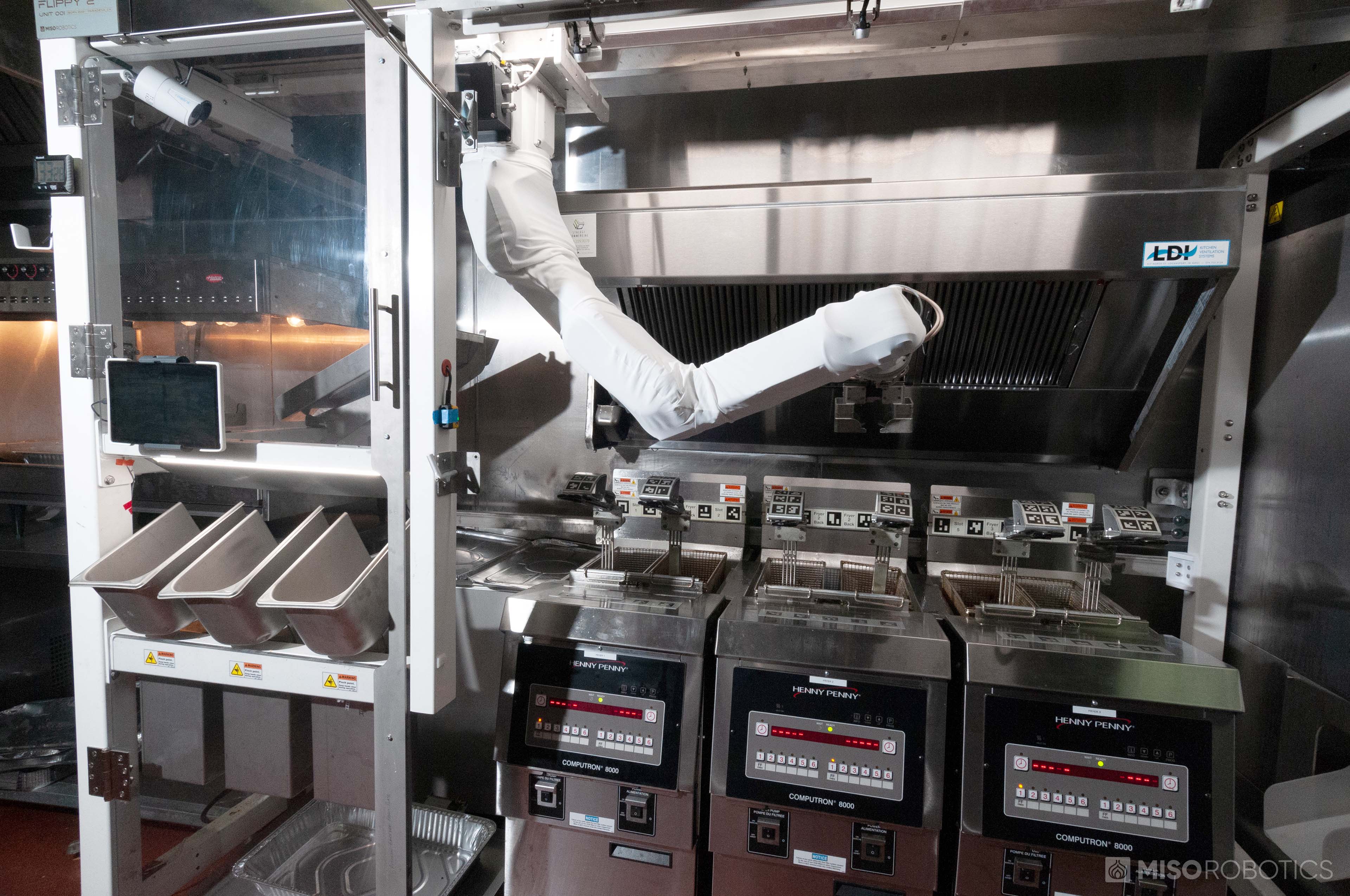
Image Credits: Miso Robotics
The subject of Miso Robotics came up a few times during my conversations with Dexai — in large part because the company has done a good job keeping itself top of mind through partnerships and expansions. I will say, the kitchen is one of those places where an arm makes sense. It’s effectively the same argument as the one fueling humanoid robot research: we build our environments for humans, so why not build robots for those environments? If you’re attempting to automate the job of a fry chef, an arm makes sense. It’s not a place where you can just plunk down a vending machine.
This week, Miso announced that Flippy will be deployed to a restaurant in the Midlands, marking its first expansion into the U.K. The company won’t disclose the name of the restaurant, only telling TechCrunch that it’s an “international fast-food chain.” The news also finds the firm turning to crowdfunded investing again, this time through the European site CrowdCube, an apparent indication that Miso is eyeing more aggressive U.K. expansion.
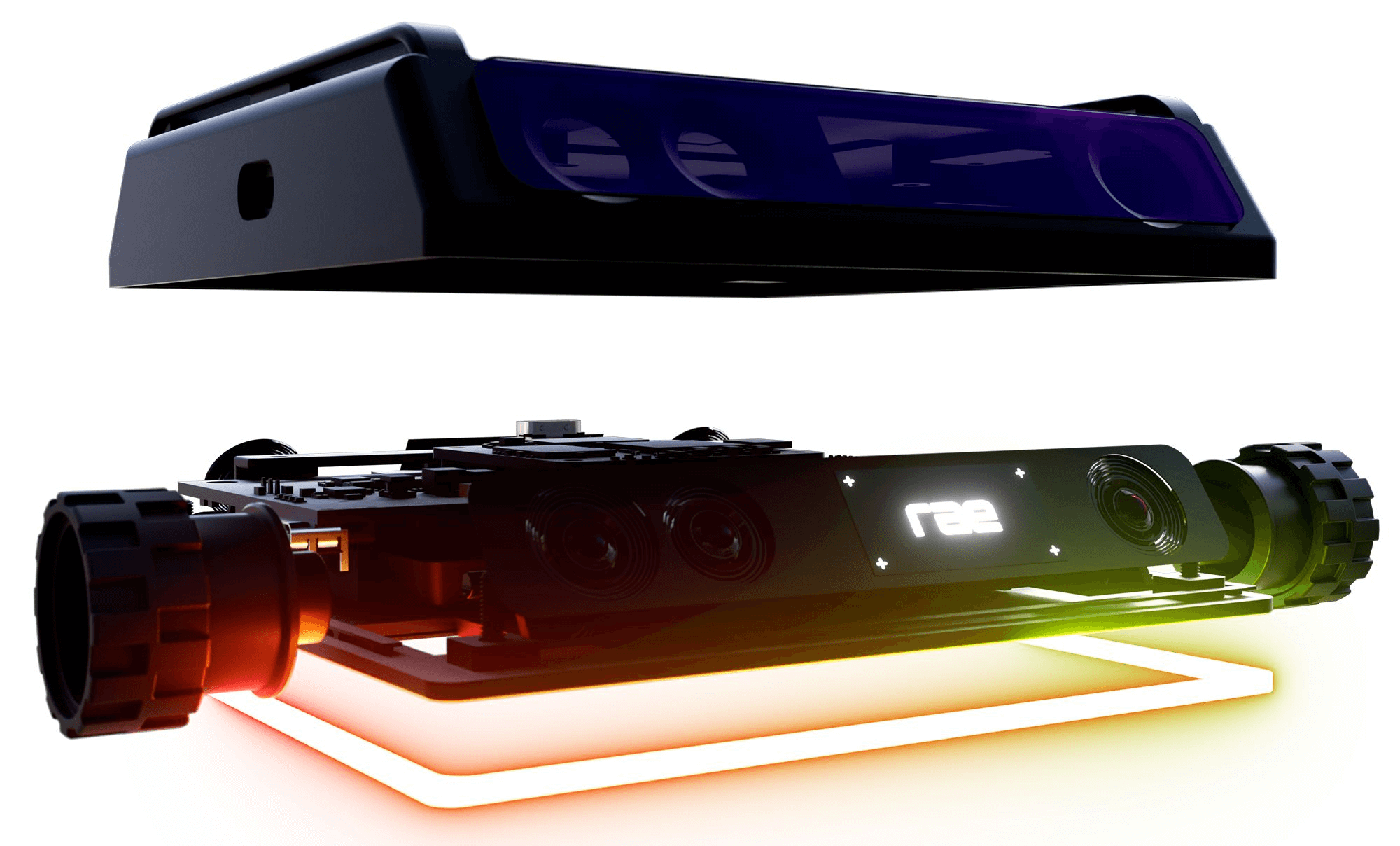
Image Credits: Luxonis
This Kickstarter campaign from Luxonis blew past its goal — and then some — almost immediately. Rae (Robotics Access for Everyone) is an open source piece of hardware designed to give users access to robotics technologies. The company says it’s designed to work out of the box, while offering up customization through its use of ROS2 and SLAM hardware. In a blog post announcing the project, the company writes:
Unlike other consumer home robots that have the majority of their functionality pre-determined, rae has potential beyond its pre-built offerings, and serves as a platform for more advanced users to create and build. If our initial software collection doesn’t solve your problem, simply develop your own. Since it’s fully open-source, rae is wide open for customization. And it will link directly to our new cloud based platform, RobotHub, for easy sharing and collaboration with a worldwide network of rae users.
Looks like a fun project for people looking to pull back the curtain a bit on the world of home robots.
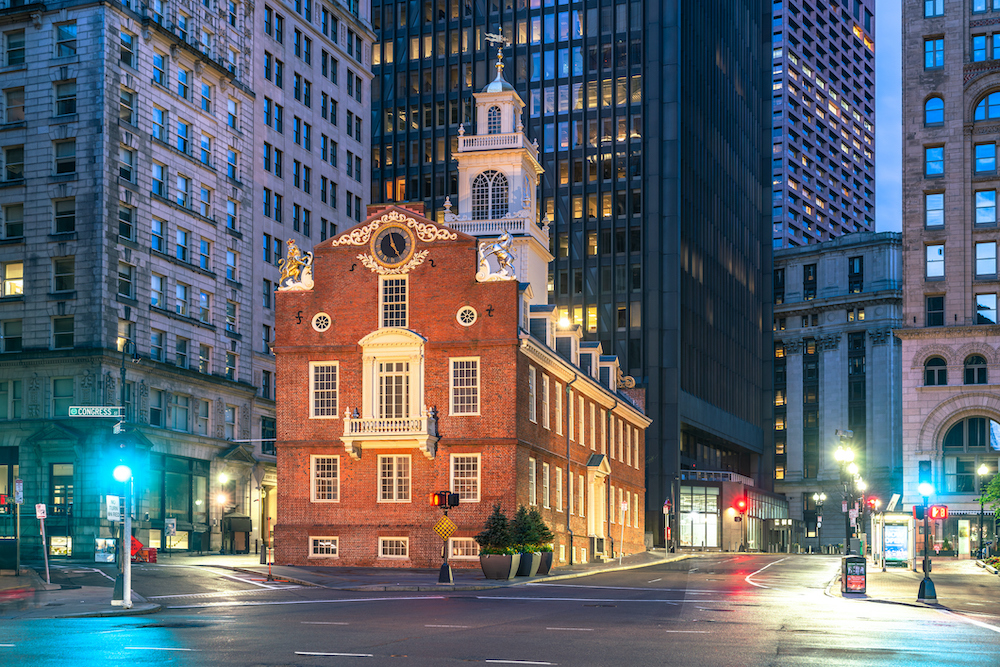
Iconic Old State House in Boston, Massachusetts. Image Credits: Ian.CuiYi / Getty Images
That’s all I’ve got in the tank for this week. I traveled to Boston specifically for the Thursday Amazon event in Westborough, while tacking on some time to meet with startups on either side — making up for a July trip I postponed due to COVID. The last few times I made work trips to the city, I took a film crew along. It’s always fun having the opportunity to shoot new startups, but the solo trip affords me the ability to jam a lot more into two days.
Amazon aside, I intentionally skipped the usual suspects like iRobot and Boston Dynamics in hopes of finding some hidden treasures. I overbooked my trip, of course. That’s just how it tends to go when I do my own scheduling. Next time I do one of these city trips, I’m going to make a point of giving myself an extra day. Without fail, you always hear of interesting new projects only after you’re on the ground. Boston people are big cheerleaders for their city and its startup ecosystem and will happily talk your ear off about all of the cool local stuff.
I regret that I wasn’t able to make visits to the labs at schools like MIT and Harvard on this trip. I was felled with COVID a third time the week before the trip, so much of this scheduling came through last minute. It also didn’t help that Friday was a holiday — though that did, comically, lead to a coffee shop musical chairs for meetings. I ended up taking one outside on a bench directly across from a construction site in Cambridge, because every spot we tried was closed. The rain, mercifully, started minutes after we were done chatting.
As a microcosm of the broader robotics community, Boston presents a great diversity in projects. Yet another reason there’s camaraderie among companies is that most everyone seems to be doing something different. They’re either focused on a different category or a different method for tackling the same problem — and for the most part, they all appear to be cheering each other on. It’s a rising tide in the very early stage of the robotics revolution in which we currently find ourselves.
I mentioned to those I was meeting with that a big part of the reason for the trip was to get the temperature of the industry at the beginning of what’s shaping up to be a difficult period for things like fundraising and hiring. It’s nice to be able to have coffee with and pick the brains of founders and investors. These are the kinds of conversations that fuel a newsletter like this for months to come. We discussed a broad range of topics, from military contracts to climate to university support to labor. Bad economic headwinds aside, it’s an extremely exciting moment to be in this industry — even if only tangentially. We’re on the cusp of something revolutionary.
Thanks to everyone in Boston for being so accommodating (shout-out to Million Year Picnic, 1369 Coffee House, Harvard Book Store and State Park’s extremely good jukebox), and thanks to you for making it through this beast of a newsletter (I lost track after word 6,000). I’ll be more pithy next week (also because Thanksgiving).

Image Credits: Bryce Durbin/TechCrunch
Want even more words about robotics delivered directly to your inbox? Subscribe to Actuator.
